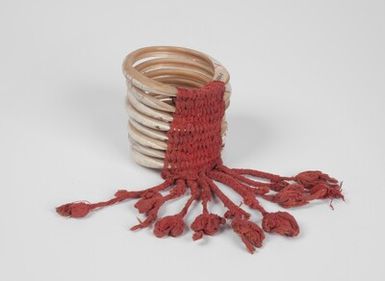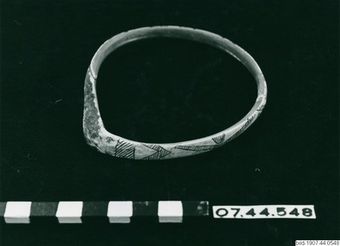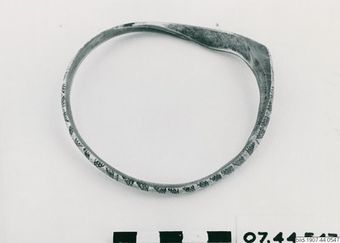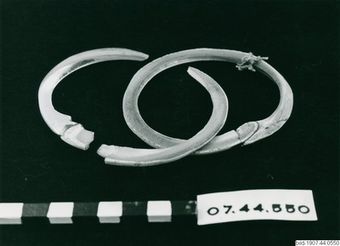Connect with National Museum of World Cultures Foundation
Contact this content partner to get more information about this item.
Top bracelet
- Description:
- In the area around Lae at the Huon Gulf there is a flourishing business in making rings from the Trochidae shell. The rings that come from here are recognizable by a carved decoration on the outside.Ó By means of a stone, the top of the shell is beaten off. The question is whether, as in New Ireland, the shell is first heated in a wood fire, or whether this is not done here. Then the bottom of the shell is beaten off. After this the base and top of the shell is ground on a grindstone under a continuous supply of water. For the grinding of the inside one uses a wooden stick, slightly carved from the top, put into the ground, on which the shell ring is placed, and with the help of a coral branch (nowadays also iron files) the inside is polished. The latter is used to hone the natural bulge of the shell.‖ In Lae on the Huon Gulf, the rings are given vertical notches for decoration on the outside.‖ Using a stone, the top of the shell is chipped off. It is questionable whether, as in New Ireland, the shell is first heated in a wood fire, or whether this is not done here. Then the bottom of the shell is beaten off. After this the base and top of the shell is ground on a grindstone under a continuous supply of water. For the grinding of the inside one uses a wooden stick, slightly carved from the top, put into the ground, on which the shell ring is placed, and with the help of a coral branch (nowadays also iron files) the inside is polished. The latter is used to polish the natural bulge of the shell.In Lae on the Huon Gulf, the rings are given vertical notches for decoration on the outside.
- Location:
- Papua New Guinea
- Format:
- image
- Collections:
- National Museum of World Cultures Foundation
- Content partner:
- National Museum of World Cultures Foundation
- Availability:
- Not specified
-
Copyright status: All rights reservedFind out more about what you are able to do with this itemThis item is all rights reserved, with means you'll have to get permission from National Museum of World Cultures Foundation before using it. For more information, please see our use and reuse page.More informationNational Museum of World Cultures Foundation has this to say about the rights status of this item:
http://rightsstatements.org/vocab/InC/1.0/
What can I do with this item?Non-infringing useNZ copyright law does not prevent every use of a copyright work, and this item may be hosted by an international institute or organisation. You should consider what you can and cannot do with a copyright work.No sharingYou may not copy and/or share this item with others without further permission. This includes posting it on your blog, using it in a presentation, or any other public use.No modifyingYou are not allowed to adapt or remix this item into any other works.No commercial useYou may not use this item commercially.
Welcome and warm Pasifik greetings
The information on this site has been gathered from our content partners.
The names, terms, and labels that we present on the site may contain images or voices of deceased persons and may also reflect the bias, norms, and perspective of the period of time in which they were created. We accept that these may not be appropriate today.
If you have any concerns or questions about an item, please contact us.



